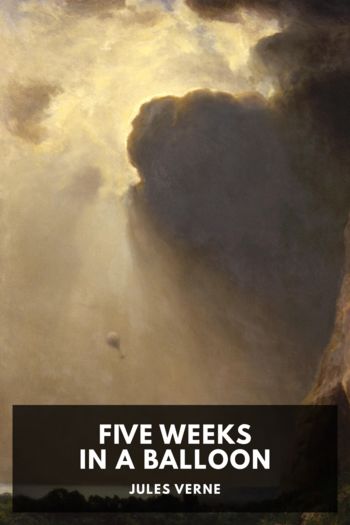Facing the Flag Jules Verne (ebook reader library TXT) 📖

- Author: Jules Verne
Book online «Facing the Flag Jules Verne (ebook reader library TXT) 📖». Author Jules Verne
The islet of Back Cup is in great part formed of calcareous rocks, which slope upwards gently from the lagoon towards the sides and are separated from each other by narrow beaches of fine sand. Thick layers of seaweed that have been swept through the tunnel by the tide and thrown up around the lake have been piled into heaps, some of which are dry and some still wet, but all of which exhale the strong odor of the briny ocean. This, however, is not the only combustible employed by the inhabitants of Back Cup, for I see an enormous store of coal that must have been brought by the schooner and the tug. But it is the incineration of masses of dried seaweed that causes the smoke vomited forth by the crater of the mountain.
Continuing my walk I perceive on the northern side of the lagoon the habitations of this colony of troglodytes—do they not merit the appellation? This part of the cavern, which is known as the Beehive, fully justifies its name, for it is honeycombed by cells excavated in the limestone rock and in which these human bees—or perhaps they should rather be called wasps—reside.
The lay of the cavern to the east is very different. Here hundreds of pillars of all shapes rise to the dome, and form a veritable forest of stone trees through the sinuous avenues of which one can thread one’s way to the extreme limit of the place.
By counting the cells of the Beehive I calculate that Count d’Artigas’ companions number from eighty to one hundred.
As my eye wanders over the place I notice that the Count is standing in front of one of the cells, which is isolated from the others, and talking to Engineer Serko and Captain Spade. After a while they stroll down to the jetty alongside which the tug is lying.
A dozen men have been emptying the merchandise out of the tug and transporting the goods in boats to the other side, where great cellars have been excavated in the rocks and form the storehouses of the band.
The orifice of the tunnel is not visible in the waters of the lagoon, and I remember that when I was brought here I felt the tug sink several feet before it entered. In this respect therefore Back Cup does not resemble either the grottoes of Staffa or Morgate, entrance to which is always open, even at high tide. There may be another passage communicating with the coast, either natural or artificial, and this I shall have to make my business to find out.
The island well merits its name of Back Cup. It is indeed a gigantic cup turned upside down, not only to outward appearance, but inwardly, too, though people are ignorant of the fact.
I have already remarked that the Beehive is situated to the north of the lagoon, that is to say to the left on entering by the tunnel. On the opposite side are the storerooms filled with provisions of all kinds, bales of merchandise, barrels of wine, beer, and spirits and various packets bearing different marks and labels that show that they came from all parts of the world. One would think that the cargoes of a score of ships had been landed here.
A little farther on is a large wooden shed the nature of which is easily distinguishable. From a pole above it a network of thick copper wires extends which conducts the current to the powerful electric lights suspended from the roof or dome, and to the incandescent lamps in each of the cells of the hive. A large number of lamps are also installed among the stone pillars and light up the avenues to their extremities.
“Shall I be permitted to roam about wherever I please?” I ask myself. I hope so. I cannot for the life of me see why the Count d’Artigas should prohibit me from doing so, for I cannot get farther than the surrounding walls of his mysterious domain. I question whether there is any other issue than the tunnel, and how on earth could I get through that?
Besides, admitting that I am able to get through it, I cannot get off the island. My disappearance would be soon noticed, and the tug would take out a dozen men who would explore every nook and cranny. I should inevitably be recaptured, brought back to the Beehive, and deprived of my liberty for good.
I must therefore give up all idea of making my escape, unless I can see that it has some chance of being successful, and if ever an opportunity does present itself I shall not be slow to take advantage of it.
On strolling round by the rows of cells I am able to observe a few of these companions of the Count d’Artigas who are content to pass their monotonous existence in the depths of Back Cup. As I said before, calculating from the number of cells in the Beehive, there must be between eighty and a hundred of them.
They pay no attention whatever to me as I pass, and on examining them closely it seems to me that they must have been recruited from every country. I do not distinguish any community of origin among them, not even a similarity by which they might be classed as North Americans, Europeans or Asiatics. The color of their skin shades from white to yellow and black—the black peculiar to Australia rather than to Africa. To sum up, they appear for the most part to pertain to





Comments (0)